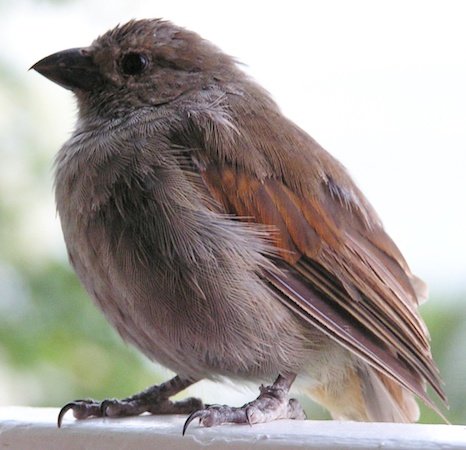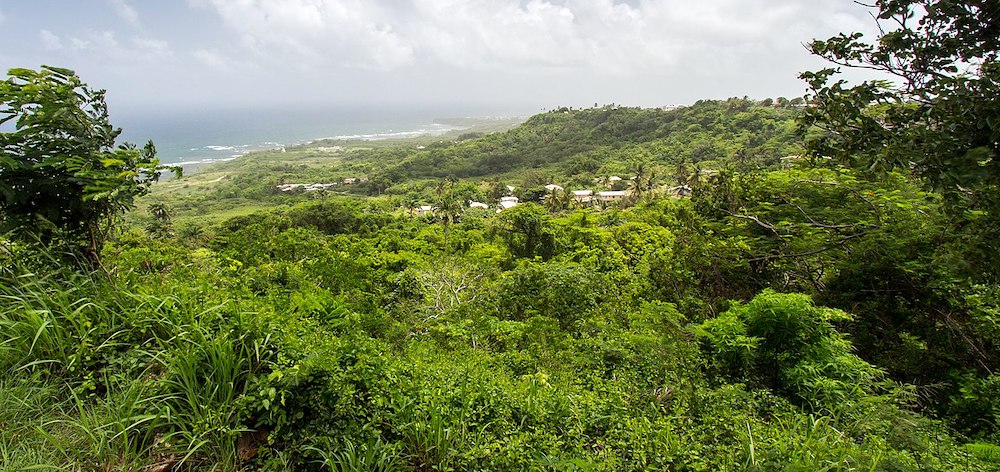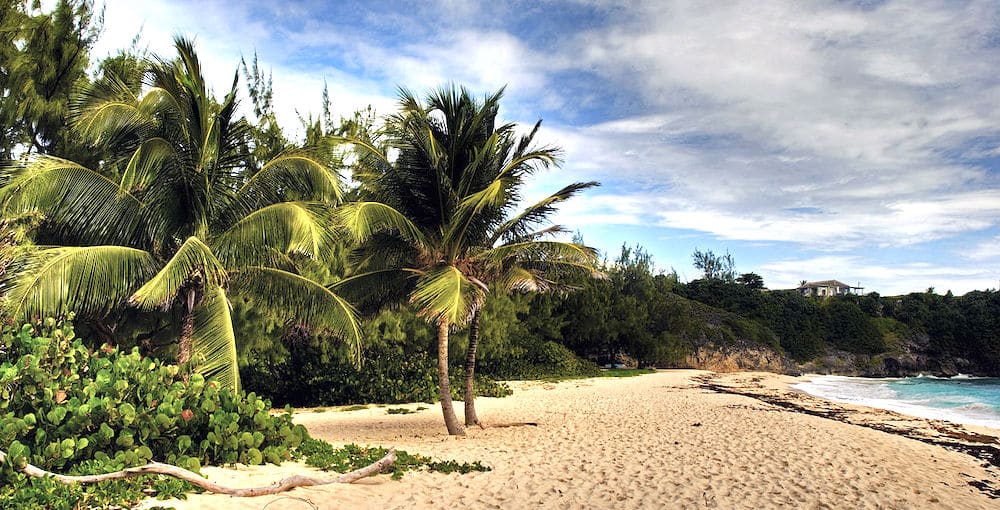Republic of Barbados

Barbados is a densely populated island country in the Lesser Antilles of the West Indies, in the Caribbean region next to North America and north of South America, and is the most easterly of the Caribbean islands. It lies on the boundary of the South American and the Caribbean Plates. It has a stable population of around 282,000 people. Its capital and largest city is Bridgetown where a third of the populous live. Other towns scattered across the island include Holetown, Oistins and Speightstown.
It is 34 kilometres (21 miles) long and up to 23 km (14 miles) wide, covering an area of 439 km2 (169 square miles). It lies about 168 km east of both the countries of Saint Lucia and Saint Vincent and the Grenadines; 180 km southeast of Martinique and 400 km northeast of Trinidad and Tobago. It is flat compared to its island neighbours to the west, the Windward Islands. The island rises gently to the central highland region known as Scotland District, with the highest point being Mount Hillaby 1,120 feet above sea level. Barbados has nearly 90 kilometres (56 miles) of coral reefs just offshore and two protected marine parks have been established off the west coast.

©bez_uk, CC BY-SA 2.0 via Wikimedia Commons
As a coral-limestone island, Barbados is highly permeable to seepage of surface water into the earth. The government has placed great emphasis on protecting the catchment areas to preserve the cleanliness of the underground springs
that lead directly into the huge network of underground aquifers and streams.
Barbados is regarded as a tropical monsoon climate. However, breezes of 12 to 16 km/h (7 to 10 mph) abound throughout the year and give Barbados a climate which is moderately tropical. The country generally experiences two seasons, one of which includes noticeably higher rainfall. Known as the wet season, this period runs from June to December. By contrast, the dry season runs from December to May. Annual precipitation ranges between 40 and 90 inches. There is little temperature variation between seasons, from December to May the average temperatures range from 21 to 31 °C, while between June and November, they range from 23 to 31 °C.
Barbados is host to four species of nesting turtles (green turtles, loggerheads, hawksbill turtles, and leatherbacks) and has the second-largest hawksbill turtle-breeding population in the Caribbean. It is also the host to the introduced green monkey, native to West Africa. It is considered a very mischievous and troublesome animal by locals.
Birding Barbados
The island of Barbados is a holiday destination better known for its sun, sea, sugarcane and beautiful white sand beaches rather than its birding, but there is much to interest a birder accidentally stranded here. Over 280 species have been recorded – more than any other Lesser Antillean island. The island offers relaxed birding and most of its 25 or so resident breeders can be seen in just one morning’s birding, or if preferred spread leisurely over a week between swimming, snorkelling and sunbathing. Unlike most of its neighbours the island was considered to have no compelling endemics, so was rarely included on a Lesser Antillean birding itinerary, but it had long been argued that Barbados’s unique form of Lesser Antillean Bullfinch (where the males resemble the females) might justify separation. It is now considered a full species and endemic.

©Berit from Redhill/Surrey, UK, CC BY 2.0 via Wikimedia Commons
Lying 150km east of its much older volcanic neighbours; its isolation, youth and non-mountainous topography are the main reasons for its limited avifauna. The island has been well-watched for several decades and has scored some notable firsts for the Americas e.g. Garganey, Black-headed Gull, Little Bittern, Alpine Swift, Collared Pratincole, Whiskered Tern, Common Cuckoo and Little Egret. Barbados was the first place in the Western Hemisphere where Little Egret was known to breed. Many vagrants turn up annually, but it is the trans-Atlantic vagrants that are of the greatest regional significance.
Most of the resident species are widespread and common and can be seen virtually anywhere including Carib Grackle, Antillean Crested Hummingbird, Green-throated Carib, Scaly-naped Pigeon, Zenaida Dove, Common Ground Dove, Grey Kingbird, Caribbean Elaenia, Shiny Cowbird, Bananaquit, Black-faced Grassquit and Yellow Warbler. Caribbean Martin and Black-whiskered Vireo are mainly summer visitors. Audubon’s Shearwaters breed at one locality. Other more local breeders include Eared Dove and Grassland Yellow-Finch, which was introduced from South America (c. 1900).
The island has limited natural wetland habitats, but the most important site is Graeme Hall Swamp, a natural mangrove swamp that has recently become a RAMSAR site. Be warned however that most of the other wetlands are small artificial swamps, created for the sole purpose of shooting migrant shorebirds from mid-July to mid-October though this fact is little known outside of Barbados. The main species shot are yellowlegs, dowitchers, plovers, Whimbrel and Pectoral & Stilt Sandpipers. (This custom is said to date back to the time of slavery, when the plantation owners had nothing better to do after the sugarcane was cut than sit in their swamps, drink fine Barbados rum and shoot).
On the plus side, some of these swamps provide good habitat for birds year-round and some owners are interested in nature, and actively discourage shooting of rare or protected species. During the shooting season when these swamps are strictly off-limits, there are still good opportunities to see shorebirds at Chancery Lane Swamp, near south point and at virtually any other grassy field after rain. A walk along the north coast can be particularly productive. Common shorebirds include White-rumped, Pectoral, Stilt and Solitary Sandpiper, Short-billed Dowitcher, yellowlegs, American Golden Plover, Whimbrel and Hudsonian Godwits that pass directly over the island, but rarely land.
-
Bayfield Pond
InformationSatellite ViewBayfield Pond, St. Philip: A roadside pond which often allows very close views of Masked Duck. -
Chancery Lane Swamp
InformationSatellite ViewThis swamp on the south coast is accessible year round but conditions vary depending on rainfall. It can be a dustbowl for much of the year. In autumn this is one of the best places to study migrant shorebirds. Rarities have included: Eurasian Whimbrel, Collared Plover, Hooded Merganser. Chancery Lane Swamp can be accessed from east and west. Leaving Oistin on H7 bear right towards Enterprise and Silver sands. At a sort of round-about straight on towards Surfers Point. Follow this road East to Chancery Lane and the sea at dead end. Walk back along coast to track inland and the swamp. OR after 1.8km from round-about take second sign right to Ealing Park South and first left into Sea View Road. In about 800m at junction with Teal turn left on tarmac for 300m and then on dirt track at No Dumping sign then left to swamp. Saloon car friendly with care when dry. -
Congo Road Swamp
InformationSatellite ViewAn artifical swamp. Inacessible during shooting season. Recent rarities in Spring have included: Little Stint, Terek Sandpiper, Curlew Sandpiper and Whiskered Tern. -
Flower Forest
WebsiteSatellite ViewFlower Forest: A good site for observing humingbirds. -
Graeme Hall Nature Reserve
Facebook PageSatellite ViewThis is easily the top birdwatching site in Barbados and the western half is a privately owned nature sanctuary. This is the best place to see the nominate race of the Yellow (Golden) Warbler, Little Egrets (breeding); and a variety of herons and shorebirds. The main pond is a reliable place to find the uncommon Caribbean Coot. In winter waterthrushes, Prothonotary Warbler and belted Kingfisher, Recent rarities have included: Grey Heron, Little Bittern, Western-Reef Egret, Purple Heron, White-winged Black Tern, European Black Tern. It is easily accessed on the south coast road. -
Inch Marlowe
Satellite ViewLocated near Chancery Lane this stretch of rocky shoreline can be a good viewpoint out to sea, though sea-watching in Barbados is usually only productive during adverse conditions. Roseate Terns visit the shoreline in summer and one or two pairs of Grassland Yellow Finches are usually present. -
Melvin's Hill Lookout
Satellite ViewMelvin's Hill Lookout, St. Joseph: The only reliable site for Black Swift in summer. -
North Coast
North Coast: Good for shorebirds and migrants. Recent Rarities include Kelp Gull, Northern Wheatear. -
Turner's Hall Woods, St Andrew
InformationSatellite ViewA small woodland site good for Black-whiskered Vireos and occasional wintering warblers. Recent Rarities have included Worm-eating Warbler and Kentucky Warbler.
-
Number of bird species: 282
(As at August 2024)
Number of endemics: 1
Barbados Bullfinch Loxigilla barbadensis
-
Avibase
PDF ChecklistThis checklist includes all bird species found in Barbados , based on the best information available at this time. It is based on a wide variety of sources that I collated over many years. I am pleased to offer these checklists as a service to birdwatchers. If you find any error, please do not hesitate to report them. -
Wikipedia
Annotated ListThis is a list of the bird species recorded in Barbados. The avifauna of Barbados included a total of 277 species, according to Bird Checklists of the World as of June 2023. Of them, one is endemic, 15 have been introduced by humans, and 184 are rare or accidental. Eight species have been extirpated and one is probably extinct. -
eBird
PDF ChecklistThis checklist is generated with data from eBird (ebird.org), a global database of bird sightings from birders like you. If you enjoy this checklist, please consider contributing your sightings to eBird. It is 100% free to take part, and your observations will help support birders, researchers, and conservationists worldwide.
-
Birds of the West Indies
| By Allan R Keith, Herbert A Raffaele, James W Wiley, Janis Raffaele & Orlando H Garrido | Helm | Edition: 2 | 2020 | Flexibound | 288 pages, 129 plates with colour illustrations; b/w illustrations, colour distribution maps | ISBN: 9781472979506 Buy this book from NHBS.com -
The Birds of Barbados
| By PA Buckley, EB Massiah, MB Hutt, FG Buckley & HF Hutt | BPU | 2009 | Hardback | 295 pages, colour plates, figs, tables | Out of Print | ISBN: 9780907446293 Buy this book from NHBS.com -
The Birds of the West Indies
| By Guy M Kirwan, Anthony Levesque, Mark W Oberle & Christopher J Sharpe | Lynx Edicions | 2019 | 400 pages, 1600+ colour illustrations, 650+ colour distribution maps | ISBN: 9788416728176 Buy this book from NHBS.com

Birds of the West Indies
AndroidThis bilingual, mobile field guide for the West Indies includes all 415 bird species of Puerto Rico and the northeastern Lesser Antilles: Virgin Islands, Anguilla, Saint Martin (Sint Maarten), Antigua and Barbuda, Montserrat, Sint Eustatius, Saint Kitts and Nevis, Saint Barthélemy (St. Barts), and Saba.
Birds of the West Indies
Apple iOS |Explore the vibrant Caribbean islands with Birds of the West Indies – your pocket guide to Caribbean birdwatching!Museums & Universities-
Barbados Museum & Historical Society
WebsiteLocated in Barbados' UNESCO World Heritage Property of Historic Bridgetown and its Garrison, the galleries of the Barbados Museum & Historical Society are housed in 19th-century military prison buildings and reveal the island's rich natural, social and military history.
Organisations-
Barbados Birds
WebsiteSome brief notes -
BirdsCaribbean
WebsiteBirdsCaribbean is a vibrant international network of members and partners committed to conserving Caribbean birds and their habitats in the insular Caribbean (including Bermuda, the Bahamas and all islands within the Caribbean basin). -
The Birds Of Barbados
Facebook Page
Reserves-
IBA Chancery Lane Swamp
InformationSatellite ViewThis protected area is home to migrant shorebirds and there is usually a presence of heron and egrets. Many North American birds rest here during their migration to South America. Chancery Lane is a seasonal wetland, so be sure to visit during the wet season as the area can dry up significantly at other times of the year. -
NR Graeme Hall Swamp & Nature Sanctuary
WebsiteSatellite ViewThere are more than 40 bird species resident in the swamp ranging from the small Sandpiper to the graceful white Cattle Egrets… -
WR Barbados Wildlife Reserve
WebpageSatellite ViewThe Barbados Wildlife Reserve occupies four acres of mahogany forest with meandering brick paths. It is a community devoted to man's love and respect for nature, as well as to research and conservation. However, its more of an open zoo than a nature reserve.
Guides & Tour Operators-
BirdFinders
Tour OperatorDay 1 Flight from London to Barbados where we will meet Ryan and transferred to our beachfront accommodation for the night. At dusk the West Indian Mahogany Trees that surround our hotel are filled with the calls of Scaly-naped Pigeons selecting their favoured roosts and the fluttering wings of Velvety Free-tailed Bats and the regional endemic Myotis nyctor (a small bat with no common name) setting out to feed. Food will of course be on our minds and after checking in, we can step down from our hotel onto the gleaming white sands that line the southern coastline of the island and enjoy a sunset stroll along the beach to Oistins fishing village where we can tuck into a delicious dinner of freshly-caught grilled fish, shrimp and lobster with other meats plus vegetarian options also available. Overnight Barbados. -
Birding Barbados
Guide & Local Tour OperatorI have been a shorebird enthusiast since the age of five. I was exposed to the centuries old culture which exists in Barbados and was lucky to have the privilege of learning from the old masters. -
Birding Barbados Tours (Damian Edghill)
Guide & Local Tour OperatorWe offer bespoke birding tours of Barbados, one of the best places in the world to watch shorebirds in particular. -
Glory Tours
Local Tour OperatorWe will show you the sights and share with you the many stories behind them and by the end of your tour you will not only see why we love this little Island Barbados so much but you will love it to. So come along and join us on a tour of Beautiful Barbados -
Rockjumper
Tour OperatorStarting from Barbados, the most easterly of the islands we embark on numerous short hops to Grenada, St. Vincent and the Grenadines, St. Lucia, Martinique, Dominica, Guadeloupe, Montserrat, Barbuda and ultimately Antigua. -
SunRise Birding
Tour OperatorAntigua, Barbados, Barbuda, Dominica, Grenada, Guadeloupe, Martinique, Montserrat, St. Lucia and St. Vincent -
The Bajan Birder
Guide & Tour OperatorAs a Professional Guide with the international organization BirdingPal, The Bajan Birder (AKA Ryan Chenery) has been leading birding tours in the Caribbean for over 15 years. Ryan has combined leading his birding excursions with a full-time career in conservation, during which he has been employed as Chief Naturalist and Eco-guide Manager at Graeme Hall Nature Sanctuary in Barbados, Environmental Consultant for PAA Management Ltd, Field Research Assistant with Global Vision International in South America, and Volunteer Development Officer with the RSPB (Royal Society for the Protection of Birds) at one of it's flagship reserves in the United Kingdom. -
WS Birding Tours
Local Tour OperatorAn island-by-island birding tour to observe all possible endemic bird species in the Lesser Antilles.
Trip Reports-
2016 [04 April] - Jesse Fagan
ReportAnnotated list of Lesser Antilles trip -
2020 [03 March] - David Asc anio
PDF ReportIn Barbados (meaning bearded and referring to the Spanish Moss hanging from large Ficus trees), we were able to observe in great detail the Barbados Bullfinch (a recent split from the Lesser Antilles Bullfinch), an Osprey, a Green Heron nesting, and the unique Green-throated Carib and Antillean Crested Hummingbird... -
2023 [06 June] - David Hollie - Lesser Antilles
PDF ReportIf you are planning to try for the bullfinch on a layover (as I was), just know that airlines in the Caribbean are quite unreliable (and InterCaribbean is a special kind of unreliable, to say the least). I ended up getting a longer layover than I bargained for, but it’s also quite possible to get a shorter-than-expected layover due to more mild (and common) delays. -
2024 [01 January] - Bill Simpson - Guyana & Barbados
PDF Report...A. Up at dawn with Barbados Bullfinches on the balcony. Spent the morning wandering west along the road and beaches casually seeing all the birds. The Hotel allowed to stay in one of the rooms till 3pm when we got another taxi back to the airport... -
2024 [03 March] - Peg Abbott
PDF ReportA grand adventure designed to showcase the endemic species of 10 Lesser Antillean Islands in 14 days - we met the challenge of multiple flights and ferries and as a group were successful in finding them all! On several islands we were joined by local guides and we learned about projects of BirdsCaribbean, an organization our visit helps support.
Other Links-
Birding The Islands
WebsiteAs a Professional Guide with the international organization BirdingPal, The Bajan Birder (AKA Ryan Chenery) has been leading birding tours in the Caribbean for over 15 years. Ryan has combined leading his birding excursions with a full-time career in conservation, during which he has been employed as Chief Naturalist and Eco-guide Manager at Graeme Hall Nature Sanctuary in Barbados, Environmental Consultant for PAA Management Ltd, Field Research Assistant with Global Vision International in South America, and Volunteer Development Officer with the RSPB (Royal Society for the Protection of Birds) at one of it's flagship reserves in the United Kingdom.
Blogs-
Birds of Barbados
BLOGBirds of Barbados is a social media initiative that aims to raise awareness and educate people about the beautiful birds of Barbados, both native and migratory, where and how to see them, the challenges they face, and the efforts to protect them...
Fatbirder - linking birders worldwide...
Skip to content
